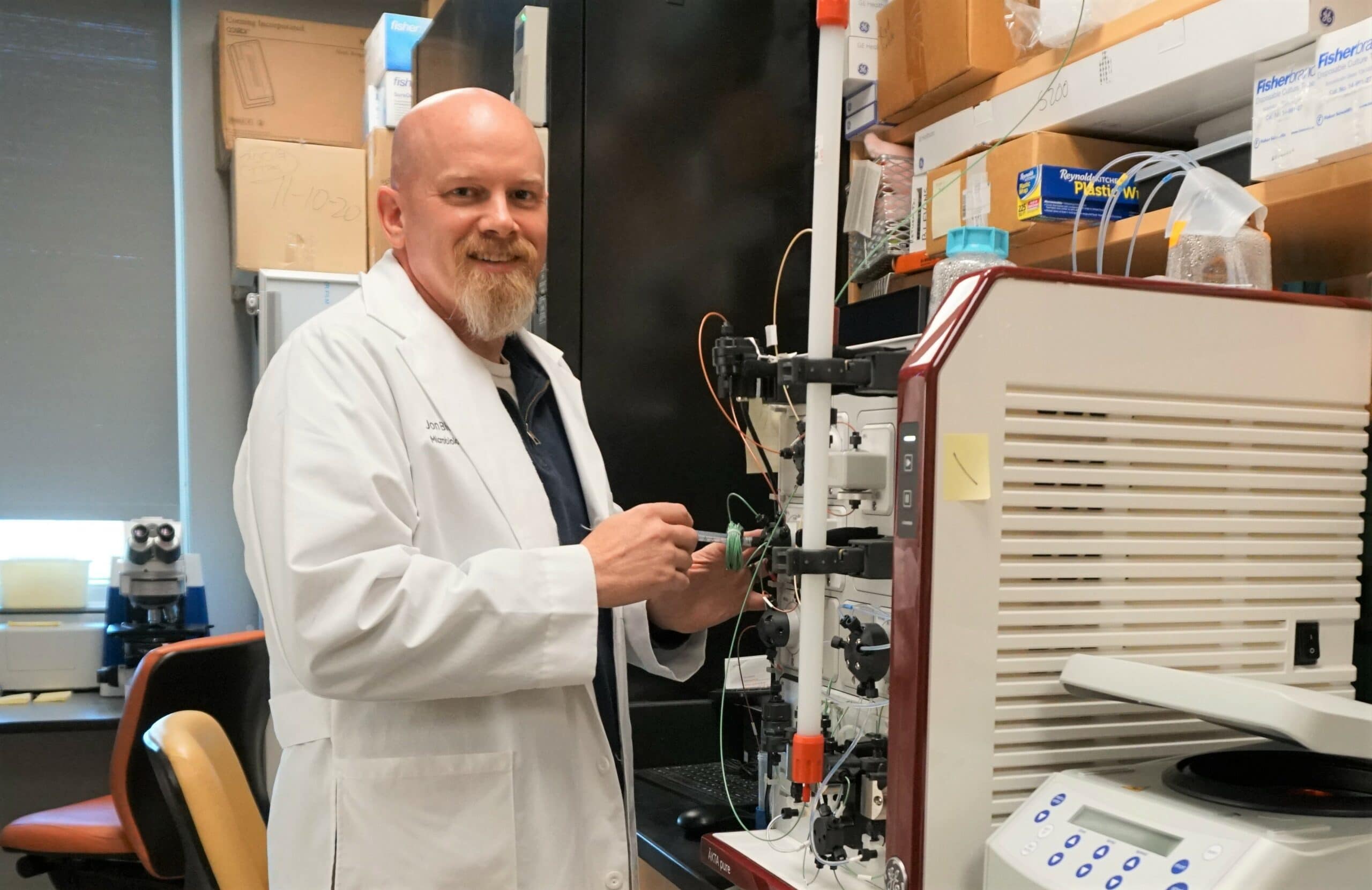UAMS Using $2.4 Million NIH Grant to Study Bacterium that Causes Tick-borne Relapsing Fever
| LITTLE ROCK — Researchers at the University of Arkansas for Medical Sciences (UAMS) will use a new federal grant to study genetic systems of the bacterium that causes tick-borne relapsing fever to better understand their molecular functions and reveal possible drug targets.
UAMS’ Jon Blevins, Ph.D., a professor in the College of Medicine Department of Microbiology and Immunology, is leading the four-year study funded by a $2.4 million grant from the National Institute of Allergy and Infectious Diseases at the National Institutes of Health (NIH).
Although they were identified over 100 years ago, scientists know very little about the spiral-shaped bacteria that cause the relapsing fever infection, which develops when bacteria are transmitted from ticks into their animal hosts, Blevins said.
“Our team now has the ability to answer a lot of questions through the power of molecular genetics,” he said, adding that, “UAMS’ state-of-the-art DNA and Next Generation Sequencing Core will play a critical role.”
Soft ticks are the primary vectors for tick-borne relapsing fever bacteria, like Borrelia turicatae. While hard ticks can transmit related Borrelia bacteria, these ticks are better known as vectors for other more common tick-borne infections, including Lyme disease, ehrlichiosis and Rocky Mountain spotted fever.
In the United States, tick-borne relapsing fever has been reported in 15 states where soft ticks live: Arizona, California, Colorado, Idaho, Kansas, Montana, Nevada, New Mexico, Ohio, Oklahoma, Oregon, Texas, Utah, Washington and Wyoming, according to the Centers for Disease Control and Prevention.
Although potentially fatal, tick-borne relapsing fever infections are relatively rare, with fewer than 100 cases reported annually in the United States, Blevins said. Infections are often linked to cave exploration or camping at rustic cabins in the mountains, where colonies of soft ticks carrying the bacteria often hide. Symptoms of relapsing fever infection include multiple recurring episodes of high fever, typically lasting about three days, followed by seven days without fever.
“I’m told by people who have had it that it’s the worst fever they’ve ever experienced,” Blevins said.
Prior to the NIH grant, Blevins and a collaborator developed methods and tools to genetically manipulate B. turicatae bacteria, which allows them to disrupt key molecular-level signaling systems and study the effects this has on the bacterium.
Known as the cyclic dinucleotide (cyclic di-AMP) second messenger signaling pathway, it is found in all pathogenic Borrelia bacteria, including the bacterium associated with Lyme disease, another important tick-borne infection.
“We know this cyclic di-AMP signaling system is extremely important because we can inactivate it in B. turicatae, and that bacterium can no longer infect an animal,” Blevins said.
“Because the bacteria require these cyclic dinucleotide-dependent signaling systems for infection, they could be great targets for developing novel antibiotics,” Blevins said. “We hope our work can also provide insight into this signaling system in the closely related Borrelia that causes the more prevalent tick-borne infection, Lyme disease.”
The research team includes collaborators at Baylor College of Medicine in Houston and University of Wisconsin-Madison.
Blevins said he was able to secure the NIH grant as a result of his earlier research of the bacterium supported by grants from the Center for Microbial Pathogenesis and Host Inflammatory Responses at UAMS. The Center is funded by the NIH Centers of Biomedical Research Excellence (COBRE). Blevins’ research was also supported by a seed grant from the UAMS vice chancellor of research.
The content of this news release on the National Institute of Allergy And Infectious Diseases award number R01AI170892 is solely the responsibility of the authors and does not necessarily represent the official views of the NIH.
UAMS is the state’s only health sciences university, with colleges of Medicine, Nursing, Pharmacy, Health Professions and Public Health; a graduate school; a hospital; a main campus in Little Rock; a Northwest Arkansas regional campus in Fayetteville; a statewide network of regional campuses; and eight institutes: the Winthrop P. Rockefeller Cancer Institute, Jackson T. Stephens Spine & Neurosciences Institute, Harvey & Bernice Jones Eye Institute, Psychiatric Research Institute, Donald W. Reynolds Institute on Aging, Translational Research Institute, Institute for Digital Health & Innovation and the Institute for Community Health Innovation. UAMS includes UAMS Health, a statewide health system that encompasses all of UAMS’ clinical enterprise. UAMS is the only adult Level 1 trauma center in the state. UAMS has 3,275 students, 890 medical residents and fellows, and five dental residents. It is the state’s largest public employer with more than 12,000 employees, including 1,200 physicians who provide care to patients at UAMS, its regional campuses, Arkansas Children’s, the VA Medical Center and Baptist Health. Visit www.uams.edu or uamshealth.com. Find us on Facebook, X (formerly Twitter), YouTube or Instagram.###
